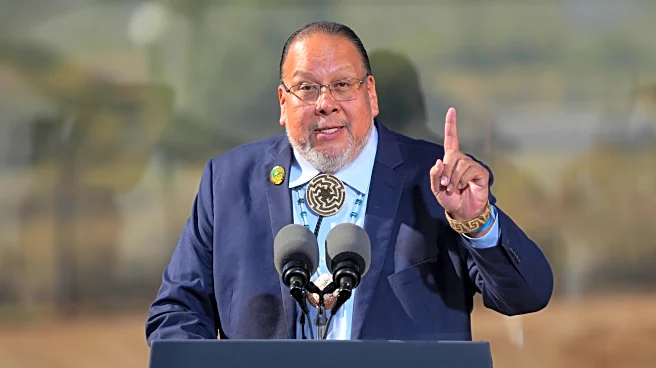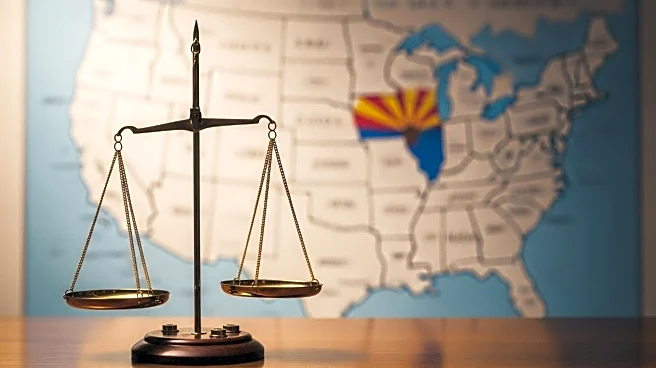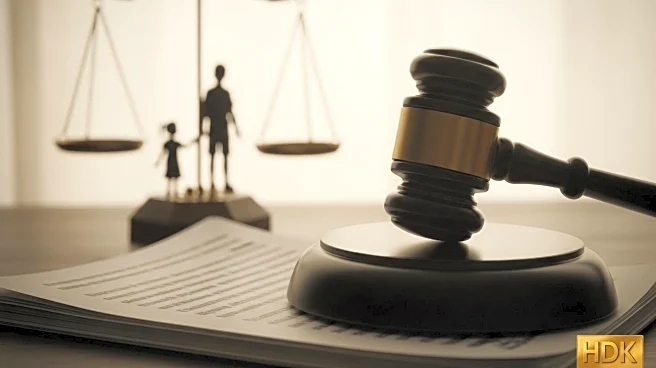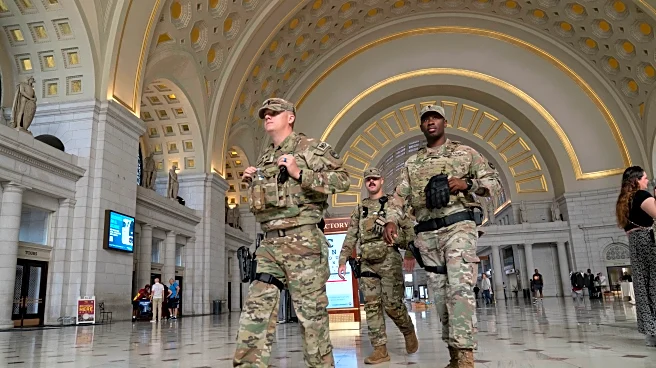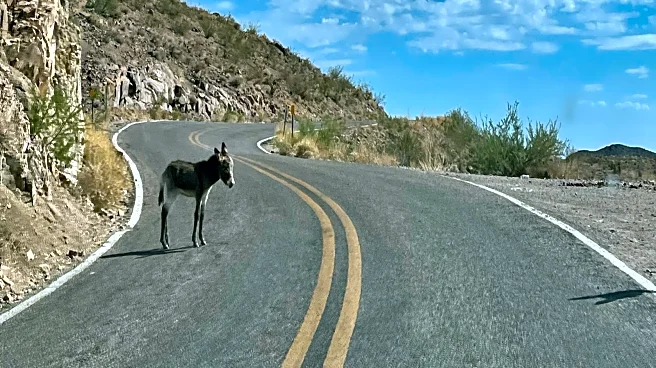The Gila River Indian Community in Arizona is weighing a new ordinance that would allow for the banishment and disenrollment of tribal members convicted of violent crimes.
If adopted, the proposal would mark the first time a tribal government in the state formalized such a measure into its criminal code.
The tribe’s council is asking members for input on the proposal through an online survey that closes Saturday, Sept. 13. The survey was initially set to close at the end of August, but was extended
on Thursday for another two weeks.
Arizona Luminaria has reviewed the survey but is not linking to it to reduce responses from people outside the tribal community.
The proposal follows months of curfews prompted by violence in the community and a recent change in law enforcement leadership that tribal officials described as part of broader efforts to enhance public safety.
The proposed ordinance would allow the tribe’s council to hold hearings to determine if tribal members convicted of a violent felony — or three violent misdemeanor offenses — should be banished, according to an introductory statement on the survey.
A banishment would prohibit a person from entering or residing on tribal lands, voting in tribal elections, participating in community-sponsored events and receiving per capita payments, the introduction states. The Gila River Indian Community is one of the few among Arizona’s 22 federally recognized tribes to provide its members per capita payments, which are regular distributions of tribal revenue that some tribal governments share with members.
The proposed ordinance would also allow the tribe’s council to approve disenrollment for members convicted of the most serious offences, including homicide, aggravated assault, kidnapping and violent sexual offense, the introduction states. Anyone facing disenrollment would be allowed to attend the council’s hearing, present evidence and call witnesses in their defense, it adds.
A banishment would not interfere with a person’s jail sentence, and disenrollment would also not affect the enrollment status or eligibility of the disenrolled member’s children, according to the survey introduction.
Questions within the survey ask tribal members to weigh in on several potential additions to the ordinance, including whether the council should be allowed to temporarily remove people from tribal land pending trial and whether these hearings should require a unanimous vote from council before moving forward with banishment or disenrollment.
Other questions seek input about the possibility of appealing a banishment or disenrollment and potential penalties that should apply to members who knowingly harbor someone who’s been banished from tribal land.
It wasn’t immediately clear when the tribe would formally consider the ordinance. A spokesperson for the Gila River Indian Community did not immediately respond to Arizona Luminaria’s request for comment.
The survey’s unveiling follows a year of mounting violence within the community and reflects recent shifts in how the Gila River Indian Community is responding to public safety.
In February, tribal Gov. Stephen Roe Lewis publicly addressed the community’s recent surge in violent crime for the first time by declaring a public safety emergency and issuing a temporary “enhanced” curfew for minors. The nightly curfew was initially set to end March 9 but has been extended several times over the last six months.
“This decision has been made to help ensure the safety of our children and young adults, particularly in light of recent events,” the February order stated. “Our community’s strength has always been built on unity, and we must take all necessary steps to protect the most vulnerable among us.”
Still, with those measures in place, Lewis announced in early April the death of Karen Peter, whom he described as an elder from District 3.
“It’s always difficult to lose members of our community, but this circumstance is especially heartbreaking and upsetting because our elder was taken from her family, her district and our community in a violent way,” he said in an April 4 video. “And this violence appears to have been perpetrated by members of our own community.”
Three people, identified only as two minors and an adult, were arrested in connection with Peter's death, according to Lewis. He did not share specifics about what happened to her, but again stressed the pattern of violence within the community and pledged to work with tribal leadership to reform policies and strengthen federal support.
“But these are only the governmental changes, that’s only part of the solution,” Lewis said. “This isn’t who we are.”
“Violence is occurring that was not part of our community in prior times, lines have been crossed that were unheard of before,” he continued. “So the solutions cannot be found in the government alone, it’s going to take all of us working together … to root out the causes of this violence.”
The proposed ordinance is just one step the tribe is taking to address violence within its community.
Another is the replacement of former Police Chief Jesse Crabtree following a month-long internal review of the department, according to an Aug. 3 statement from the tribe.
It’s unclear what led to the review or its findings, but the tribe said it has since launched a nationwide search for new leadership and appointed 25-year department veteran Jeff Hunter as acting chief in the meantime.
“This transition is the next step in a broader effort to enhance public safety, and align the Gila River Police Department more closely with the needs and expectations of the Community, its members and leaders,” the tribe’s statement said.
Recent statistics from the tribe’s police department — published in the May and July editions of the Gila River Indian News — show shifts in reported crime between April and June. The data reflects calls for service only, meaning it’s merely a snapshot of how incidents were initially reported to police and may not have resulted in an actual crime.
Reports related to violent offenses — including simple and aggravated assault, burglary and robbery — declined in June compared to April, while property crimes, alcohol-related incidents and “shots fired” calls rose across several districts. District 3, where Lewis said Peter lived, saw one of the sharpest increases in gun-related calls, jumping from 44 in April to 64 in June.
Furthermore, the tribe’s nightly curfew order for minors was again extended on Thursday for a fifth time and will remain active through the end of the year. In the order, officials acknowledged some improvement but emphasized that “concerns over crime and threats to public safety remain,” even in the months after Peter's death.
The order noted that much of the violence in the community was occurring at night.
It’s not immediately clear how common it is for tribes to adopt laws that banish or disenroll members for committing violent crimes.
While all 574 federally recognized tribes have the authority as Sovereign Nations to exclude people from their lands, few appear to have publicly codified laws that specifically banish or disenroll members convicted of violent offenses.
A recent example comes from the Bay Mills Indian Community in Michigan. In November 2023, the tribe adopted a banishment ordinance for anyone who commits domestic violence, sells or traffics drugs or is a registered sex offender on their land. It also allows the tribe to banish people who threaten natural resources or the environment.
The tribe’s process requires an investigation by tribal police, and the final decision to banish can only be made by the tribe’s council. If approved, the banishment is permanent. The ordinance, however, does not mention disenrollment as part of the process.
David Wilkins, a citizen of the Lumbee Nation and expert on tribal sovereignty and law, estimates between 3,000 and 9,000 people have been disenrolled across Tribal Nations in the U.S., and about 15% of all federally recognized tribes have carried out disenrollment or banishment practices in some capacity.
However, many of those instances were on a case-by-case basis as ordinances related to banishment are rare and relatively new, he told Arizona Luminaria during a phone call. One example is the Tohono O’odham Nation, whose criminal code references banishment as a trigger for trespassing charges against members but does not appear to include a formal law that defines or governs the banishment process itself.
“Very few tribes had any ordinance whatsoever, any laws about banishment,” Wilkins said, adding that more often tribes have clauses related to disenrollment, but those mostly center on ancestry or dual enrollment issues rather than criminal conduct.
“So the word ‘exile’ is used, the word ‘disenrollment’ is used, the word ‘remove from office’ is used, but not the word ‘banishment,’” he continued. “That is a really recent phenomenon because, until the early ’90s, tribes weren’t either banishing or disenrolling their citizens.”
Wilkins has closely studied the impact banishment and disenrollment have on tribal citizens across the country, culminating in a book he co-authored with his wife, Shelly Wilkins, titled “Dismembered: Native Disenrollment and the Battle for Citizenship.” Based on their research and dozens of interviews, he described the practices as deeply harmful to a person’s sense of identity and a major break from how Indigenous communities have traditionally handled conflict.
“What they all emphasize was the emotional trauma of being told by someone who you had always known, that you were related to … that you don’t exist as a tribal citizen in their eyes,” Wilkins said.
“Not so much the material things that they’re going to be losing,” he continued, noting that many disenrolled or banished citizens also lose access to housing, health care and other services. “You have lost your identity as an Indigenous person and that is the most crippling, the most traumatic thing that most of our interviewees told us.”
Some tribes have turned to banishment and disenrollment out of frustration, especially when state or federal agencies fail to respond or offer support, Wilkins said. Though he warned it’s not a long-term solution for public safety issues.
“It’s a policy that really makes no sense, particularly in contemporary times, because that individual, particularly if they’re a bad actor, they’re just going to go next door and start continuing to do what they’ve been doing” Wilkins said.
“It just kicks the problem down the road, kicks the can down the road, and it puts the burden then on the state or the county or whoever is next door to that particular community.”
Wilkins urged Tribal Nations to instead focus on traditional Indigenous practices rooted in kinship, relational accountability and community healing. “We understood that we were a community of related citizens,” he said. “And if you’re related to someone, you have that sense of responsibility.”
“The idea is, you don’t surround yourselves by rights, you surround yourselves by a sense of responsibility,” he continued. “You look out for your neighbor because you know they’re going to be looking out for you.”
___
This story was originally published by Arizona Luminaria and distributed through a partnership with The Associated Press.
